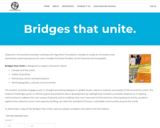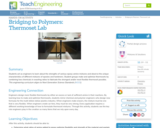
"Brer Rabbit Down the Well" from Usborne's Illustrated Stories from Around the World is read aloud.
- Subject:
- English Language Arts
- Material Type:
- Activity/Lab
- Date Added:
- 12/15/2020

"Brer Rabbit Down the Well" from Usborne's Illustrated Stories from Around the World is read aloud.

The Listening Guide for "Brer Rabbit Down the Well" is attached.

"Rock-star physicist" Brian Cox talks about his work on the Large Hadron Collider at CERN. Discussing the biggest of big science in an engaging, accessible way, Cox brings us along on a tour of the massive project. A quiz, thought provoking question, and links for further study are provided to create a lesson around the 15-minute video. Educators may use the platform to easily "Flip" or create their own lesson for use with their students of any age or level.

Physicist Brian Greene explains superstring theory, the idea that minscule strands of energy vibrating in 11 dimensions create every particle and force in the universe. A quiz, thought provoking question, and links for further study are provided to create a lesson around the 19-minute video. Educators may use the platform to easily "Flip" or create their own lesson for use with their students of any age or level.

Students will understand the structural importance of the arch shape in bridge design. Students will compare and contrast modern arch bridges to historical arch bridges. Students will design and sketch their own arch bridge design.

Students will understand what a cable-stayed bridge is and its structural importance. Students will identify the different key parts of a cable-stayed bridge. Students will study how the forces of compresion and tension are distributed on this type of bridge. Students will make comparisons between cable stayed bridges and other bridges that they are familiar with. Students will design and construct a scale sketch of their own cable-stayed bridge.

Students will understand how suspension bridges work. Students will identify the main parts of a suspension bridge. Students will know the signifigance of suspension bridges to modern construction. Students will design and draw their own suspension bridge. Students will learn what civil engineers put into consideration when designing a suspention bridge.

Students will learn the geometry and structural importance of a truss which allows it to be used to make bridges. Students will work in pairs to design, build, and test the strength of their own small wooden truss bridge. Students will know the importance of materials used in truss bridges.

This lesson provides teachers with support for using text-dependent questions to help students derive big ideas and key understandings while developing vocabulary using the fictional text The Bridge Dancers. In this book, two sisters, Maisie and Callie, are faced with a challenging situation. Callie gets hurt while their mother is away and Maisie must decide if she can rely on her knowledge of herbal medicine to save her sister's life.

Students explore how tension and compression forces act on three different bridge types. Using sponges, cardboard and string, they create models of beam, arch and suspension bridges and apply forces to understand how they disperse or transfer these loads.

Through a five-lesson series that includes numerous hands-on activities, students are introduced to the importance and pervasiveness of bridges for connecting people to resources, places and other people, with references to many historical and current-day examples. In learning about bridge types arch, beam, truss and suspension students explore the effect of tensile and compressive forces. Students investigate the calculations that go into designing bridges; they learn about loads and cross-sectional areas by designing and testing the strength of model piers. Geology and soils are explored as they discover the importance of foundations, bearing pressure and settlement considerations in the creation of dependable bridges and structures. Students learn about brittle and ductile material properties. Students also learn about the many cost factors that comprise the economic considerations of bridge building. Bridges are unique challenges that take advantage of the creative nature of engineering.

In this unit of study students learn about different types of bridges and how to design and build their own bridge. This unit integrates nine STEM attributes and was developed as part of the South Metro-Salem STEM Partnership's Teacher Leadership Team. Any instructional materials are included within this unit of study.

This resource encourages students to deepen their understanding of global poverty—to see our connections to the rest of the world, to explore the roots of inequities and to understand the importance of assistance that preserves human dignity, values diversity and unleashes the inherent power of community.
Experience has shown that successful development is possible—if initiatives invest in people and ensure that beneficiaries over time become the owners of the development process. This means addressing the intertwined causes of poverty and helping communities mobilize their resources so that they can help themselves. ultimately, it means providing a hand up instead of a handout. The stories contained in this resource draw on the long-term experience of Canada and Canadians in the developing world, and encourage students to see themselves as part of the bridge of hope that unites us as global citizens.
Tips for using this resource:
The lessons in this resource have been created as a unit that builds foundational understanding and encourages exploration of key concepts and critical global issues to allow for deeper learning and meaningful attitudinal change. While we recommend that the lessons be used together, each set of lesson activities can also stand alone to provide learning opportunities around a particular aspect of international development. The term “lesson” does not imply that it can be completed within one class. Class periods vary with timetables, and experience in co-operative learning, language levels and group dynamics can all affect the time needed to complete these activities. The teacher is the best judge of these factors.
Curriculum Connections:
The themes and concepts presented provide excellent links to Ministry of Education curricular objectives/
expectations in Social Science, history and Geography programs across the country. activities also maximize a
variety of specific skill-based objectives/expectations and competencies such as critical thinking, problem solving, communication, social skills and map analysis. Each lesson outlines general objectives/expectations to assist teachers in program planning. The activities can easily be adjusted for grade and level by providing varying degrees of support, allowing additional time and adjusting expected outcomes.

Watch and learn how The Bridge to Land Water Sky is changing the face of agriculture in Saskatchewan and helping bring Canada closer to its goal of reducing carbon emissions 30% by 2030. This Indigenous-led movement is a partnership between Mistawasis Nêhiyawak, Muskeg Lake Cree Nation, the Redberry Lake Biosphere Region, the North Saskatchewan River Basin Council, Local Agricultural Producers and Agriculture and Agri-Food Canada.

During interactive read-aloud sessions, students identify how an author conveys mathematical information about animals' sizes and abilities. They then conduct research projects focusing on the same mathematical concepts.

Students are presented with a brief history of bridges as they learn about the three main bridge types: beam, arch and suspension. They are introduced to two natural forces tension and compression common to all bridges and structures. Throughout history, and today, bridges are important for connecting people to resources, places and other people. Students become more aware of the variety and value of bridges around us in our everyday lives.

Students act as engineers to learn about the strengths of various epoxy-amine mixtures and observe the unique characteristics of different mixtures of epoxies and hardeners. Student groups make and optimize thermosets by combining two chemicals in exacting ratios to fabricate the strongest and/or most flexible thermoset possible.

This is a brief guide to NOTICING, with young narrators giving advice on how we all can be first class noticers every day!

This collection of activities is based on a weekly series of space science problems distributed to thousands of teachers during the 2009-2010 school year. They were intended for students looking for additional challenges in the math and physical science curriculum in grades 9 through 12. The problems were created to be authentic glimpses of modern science and engineering issues, often involving actual research data. The problems were designed to be åÔone-pagersåÕ with a TeacheråÕs Guide and Answer Key as a second page. This compact form was deemed very popular by participating teachers.

As a culminating activity for "Slaughterhouse-Five", students make a compilation album (a CD with 6-8 tracks) that reflects their analysis, understanding, and reaction to the ideas in the novel "Slaughterhouse-Five".